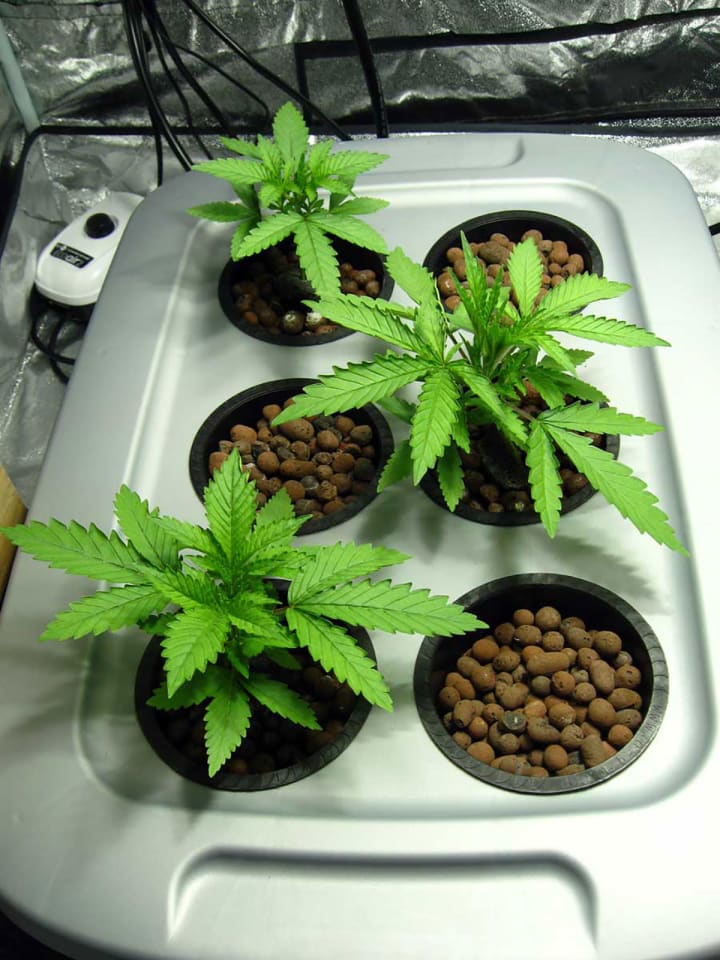Indoor Marijuana Growing Advice
Do not use any soil whatsoever. Instead, follow our indoor marijuana growing advice to optimize your germination success.

Do not use any soil whatsoever. Instead, use a prepackaged soil-less mix. Three good brands commonly available are Premier Pro-Mix BX BioFungicide, Sun Gro Metro Mix, and Roots Organics, along with many other good brands sold in different parts of the country. The package should say "soil-less mix," "peat-lite mix," or "cornell-mix." The package should not say "potting soil," "top soil," "humus," etcetera.
What's the difference? Soil contains humus, whereas soilless mediums do not. Humus is great in the outdoor garden, but unnecessary in the indoor pot. Humus releases essential nutrients to plants at a rate which is highly unpredictable, and even less controllable. We can easily bypass this anarchic factor by combining a soilless medium with a controlled nutrient feeding program using fertilizers. In doing so, the plants are assured of receiving the optimum level of nutrients at every stage of development.
As it comes from the bag, most soilless mediums don't drain quite well enough for cannabis and are slightly more acidic than cannabis prefers. Consequently, the following ingredients should be mixed in thoroughly before using the soil-less mix:
- 1/2 teaspoon dolomitic lime per quart soil-less mix
- 1 quart perlite or coarse sand per 4 quarts soil-less mix
These ingredients will probably be available from the same outlet which stocks the soilless mix. We suggest regular grade agricultural perlite for plants under two months old, and sand or some combination of sand and perlite for older plants. Any coarse (e.g., construction) sand will do, as long as it isn't beach sand. Never use fine sand.
In the rest of this article, we will use the word "soil" solely for the sake of convenience. We will actually be referring to the soilless growing medium described above.
Germination

Forget all those charts and drawings you may have seen describing elaborate germination chambers. They're not only unnecessary, but they require later transplanting, which is fairly tricky in the case of very young cannabis seedlings. Choose good seeds, keep them moist, allow for 4" of root depth, and supply loads of constant light. That's all it really takes.
Don't choose solid pale green or creamy white seeds, and don't choose the dark crusty-looking ones. The large, slightly spotty-looking seeds have the best chances of germinating.
Before planting any seeds, soak them in a small amount of distilled water for about 24 hours. The water should be room temperature or slightly warmer.
We strongly recommend Jiffy-7 pellets as the best possible germinating medium. These pellets are available at most nurseries and garden centers. Before planting any seeds in these pellets, the pellets should first be soaked in water mixed with plenty of dolomitic lime. Otherwise, the salesman will explain how to use these pellets for seed germination.
If you don't use the Jiffy-7 pellets, the best alternative is simply to fill plastic pots 4" in depth and diameter with the soilless mix discussed earlier. Insert several seeds 1/4" deep in each pot. Gently add water until the soil is thoroughly moistened, but not wringing wet. Cover the tops of the pots tightly with clear plastic. There should be a space of about 1/2" between the soil line and the plastic. Place any type of fluorescent tube 2" above the pots (or Jiffy-7 pellets). The plastic will prevent the medium from drying out from the light. Keep the light on 24 hours a day for the next two weeks. As seeds begin to germinate, remove the plastic. Once the seedlings have several leaves per plant, the lights should be raised to 6" above the plant tops, and a 16 to 17 hour photo period should be started.
Whenever more than one plant per pot (or pellet) germinates, allow only the healthiest-looking plant to grow. Extra plants should be destroyed by cutting their stems with a scissors at the soil line. Never allow two or more plants to grow in the same container.
If no seeds germinate within two weeks after planting, use seeds from a different source.
Containers

Use plastic pots only. Yes, clay pots do "breathe" better, but the suggested growing medium will breathe more than adequately on its own in plastic. The medium will dry out too quickly in clay pots.
Start out with the plants in pots 4" in depth and diameter. When they're five or six weeks old, they should be re-potted into pots 6 to 7" in depth and diameter.
Always re-pot in dim light, as roots exposed to bright light may suffer damage. Before re-potting, thoroughly moisten the fresh soil in the larger pot, as well as the old soil in the smaller pot. Hold the plant upside down, supporting the main stem at the base with one hand. Squeeze and tap on the upside down pot until the soil just falls out of the pot with roots and all in one big clump. Put this clump in the larger pot, with as much of the old soil as possible still clinging to the roots. Fill in around the edges with the new soil. Then water the plant thoroughly.
Watering

Let the plants tell you when to water. If you think a plant may need water, stick your finger a third of the way down from the top of the soil. If you feel any moisture, don't water the plant. If it's all dry, then water the plant. Water thoroughly. You haven't finished watering the plant until some water drips out of the drainage holes at the bottom of the pot. If there are no holes in the bottom of your container, either switch to a container that has holes, or punch some out in the existing container.
The frequency of watering will vary between every day to once every 10 days, depending on root development in relation to pot size. Newly repotted plants will normally take a week or more before they need water. Plants sitting in the same pot for a couple of months may beg you for water every day. If any plants are drying out every day or two, then it's time to re-pot them into a slightly larger container, even if it doesn't fit in with the schedule described above.
Water should always be room temperature.
About the Creator
Hydro Wilson
Of Alpha Kappa Nu fame. Grew up in Boulder, Colorado. Addicted to Halo.






Comments (1)
IMO adding lime to a soilless medium goes against the laws of physics. The ph range of a soilless medium is 5.5 to 6.2. Adding lime screws all of that up. I don't understand the logic behind that recommendation.